Best Mirrorless Cameras for Beginners in 2024
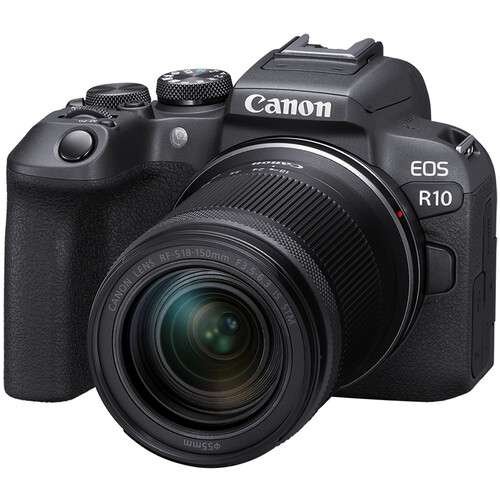
If you’re stepping into the world of photography, a mirrorless camera could be your perfect companion. These cameras are prized for their lightweight build, portability, and the flexibility of interchangeable lenses. Whether you’re a budding photographer or a beginner videographer, mirrorless cameras offer an appealing balance of features without breaking the bank.
Given the abundance of options in the market, we’ve compiled a comprehensive list of the best mirrorless cameras for beginners. Ranging from budget-friendly models ideal for entry-level photography to sophisticated options crafted for top-tier content creation, our selection caters to diverse preferences and skill levels.
No matter which camera you choose from our curated list, rest assured that you’ll be equipped to capture stunning images and videos. With their user-friendly interfaces and impressive capabilities, these entry-level mirrorless cameras promise to deliver exceptional results, empowering you to unleash your creativity and embark on your photographic journey with confidence.
Best Mirrorless Camera for Beginners
Canon EOS R10
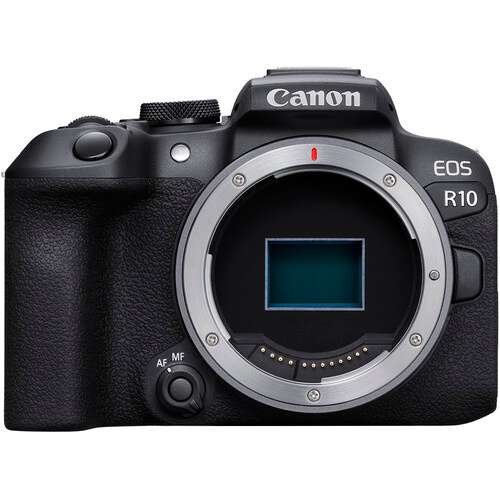
Canon EOS R10 Key Specs:
- 24.2MP APS-C CMOS Sensor
- Dual Pixel CMOS AF II
- 4K30 Video, 4K60 with Crop; HDR-PQ
- 23 fps E. Shutter, 15 fps Mech. Shutter
- 2.36m-Dot OLED EVF
- 1.04m-Dot Vari-Angle Touchscreen LCD
- Multi-Function Shoe, Wi-Fi and Bluetooth
- Single UHS-II SD slot
- Weight: 382.2 g (Body Only), 429.2 g (With Battery, Recording Media)
- Store links at B&H, Adorama.
Pros:
- Compact and lightweight
- Speedy burst mode
- Impressive autofocus
- 4K video
- Good value
Cons:
- No weather sealing
- No in-body stabilization
- Cropped 4K/60p video
- Single card slot
The Canon EOS R10 emerges as a standout among entry-level mirrorless cameras, boasting a plethora of features that cater to both novice photographers and casual content creators. Its ergonomic design and user-friendly interface make it a breeze to operate, ensuring a seamless experience for beginners venturing into the realm of photography. While its price point may not suit everyone, those who can afford it will find its performance well worth the investment.
Equipped with a 24.2MP APS-C CMOS sensor, the EOS R10 delivers impeccable image quality, capturing intricate details with finesse. Its versatility extends beyond photography, excelling in video production and vlogging endeavors. The camera’s robust battery life and reliable autofocus system further enhance its appeal, ensuring consistent performance even in demanding shooting conditions.
Video enthusiasts will particularly appreciate the EOS R10’s fast and precise autofocus system, which effortlessly tracks moving subjects, resulting in crisp and detailed 4K videos achieved through advanced oversampling techniques. Additionally, its ability to record slow-motion-capable Full HD video at 120 frames per second adds a layer of creativity to videography projects. For enhanced connectivity and creative flexibility, the camera offers clean 4K video output via the Micro-HDMI port, opening doors to a myriad of post-production possibilities.
The EOS R10’s compatibility with a wide array of lenses, including both APS-C format and premium full-frame options, underscores its versatility and potential for growth. Whether you’re a budding photographer or an aspiring filmmaker, the camera provides ample room for exploration and expansion of creative horizons.
In summary, the Canon EOS R10 stands as a compelling choice for beginners and social media enthusiasts alike. It strikes a balance between advanced functionality, compact design, and affordability, serving as an ideal entry point into Canon’s esteemed EOS R ecosystem. Whether you’re documenting your adventures, capturing captivating stills, or delving into the world of videography, the EOS R10 empowers you to unleash your creativity and hone your skills as a content creator.
Canon EOS R10 body at B&H, Adorama.
Canon EOS R10 with 18-45mm Lens at B&H, Adorama.
Canon EOS R10 with 18-150mm Lens at B&H, Adorama.
See also:
Best Mid-Range Mirrorless Camera for Beginners
Sony a6400

Sony a6400 Key Specifications:
- 24.2MP APS-C Exmor CMOS Sensor
- BIONZ X Image Processor
- Real-Time Eye AF & Real-Time Tracking
- XGA Tru-Finder 2.36m-Dot OLED EVF
- 3.0″ 921.6k-Dot 180° Tilting Touchscreen
- Internal UHD 4K Video, S-Log3, and HLG
- S&Q Motion in Full HD from 1-120 fps
- Built-In Wi-Fi with NFC
- 425 Phase- & Contrast-Detect AF Points
- Up to 11 fps Shooting and ISO 102400
- Weight: 359g (Body Only), 403g (With Battery, Recording Media)
Pros:
- 4K video without recording limit
- Excellent overall autofocus performance
- Compact, lightweight design
- High-quality electronic viewfinder
- Good battery life
Cons:
- No in-body image stabilisation
- Dated rear screen and EVF
- Minimal touchscreen functionality
If the Canon EOS R10 exceeds your budget, considering a Sony APS-C Alpha camera like the Sony a6400 could offer a compelling compromise between cost and performance. While the a6400 may show signs of aging with its outdated user interface and somewhat lacking ergonomics, its sensor capabilities still deliver excellent image quality. Moreover, the camera maintains one of the most proficient autofocus systems within its class, even by contemporary standards.
For those aiming to be more budget-conscious, the Sony a6100 presents a viable option, utilizing the same sensor but with compromises such as a lower-resolution EVF and a marginally less robust build. On the other hand, opting for the pricier Sony a6600 grants access to the same sensor while offering enhancements like a more durable body, a larger battery capacity, and IBIS (In-Body Image Stabilization).
Although each camera – Sony a6400, a6100, and a6600 – comes with its own set of nuances, the disparities between them are relatively minor. Consequently, the best choice among them largely depends on individual budget considerations, ensuring that all three remain viable options for photographers seeking quality performance within their financial constraints.
Sony a6400 body at B&H, Adorama.
Sony a6400 with 16-50mm Lens at B&H, Adorama.
Sony a6400 with 18-135mm Lens at B&H, Adorama.
See also:
Best Budget Mirrorless Camera for Beginners
Canon EOS R50
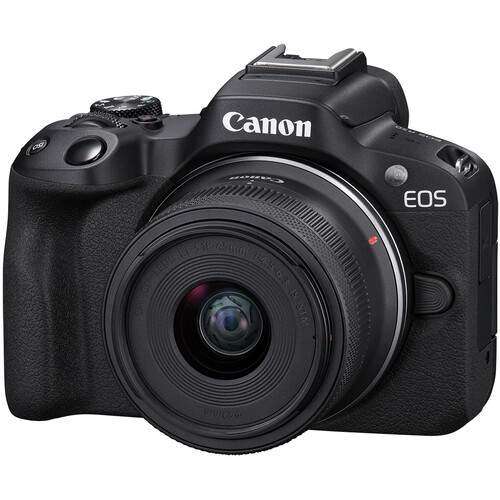
Canon EOS R50 Key Specifications:
- 24.2MP APS-C CMOS Sensor
- DIGIC X Image Processor
- UHD 4K 30p Video Recording, Full HD Video up to 120 fps
- Dual Pixel CMOS AF II with 651 Zones
- 2.36m-Dot Electronic Viewfinder
- 3.0″ 1.62m-Dot Vari-Angle Touchscreen
- 15 fps Electronic Shutter
- Movie for Close-Up Demos Mode
- Vertical Movie Mode
- Multi-Function Shoe, Wi-Fi & Bluetooth
- Weight: 328 g (Body Only), 375 g (With Battery, Recording Media)
- Store links at B&H, Adorama.
Pros:
- Fantastic autofocus with subject recognition
- UHD 4K 30p video oversampled from 6K
- Front-facing LCD and eye-level EVF
- Very compact and lightweight
- Great image quality
- Affordable
Cons:
- No in-body image stabilization
- No weather-sealing
The Canon EOS R50 is an excellent budget-friendly camera designed for beginners and content creators. With its compact size and fully articulating LCD touchscreen, it is incredibly easy to use and navigate. The camera’s grip is comfortable, and the screen can flip all the way around, making it ideal for selfies and vlogging.
One standout feature of the EOS R50 is its uncropped 4K video capability. The footage is oversampled from 6K, resulting in sharp and clear video quality. However, it’s important to note that the camera lacks in-body image stabilization (IBIS) beyond digital IBIS, so a gimbal might be necessary for stable shots while filming.
While the R50 is budget-friendly, it still offers the versatility of an interchangeable lens camera. The kit comes with the RF-S 18-45mm f/4.5-6.3 IS STM lens, but users can invest in other lenses for different shooting needs.
The camera’s 24.2MP APS-C sensor, combined with the RF-S lenses, produces excellent images for web and reasonably sized prints. Although these lenses may not be in the same class as Canon’s high-end L series optics, they provide satisfactory results without adding significant weight or bulk to the camera.
With its user-friendly interface and lightweight design, the Canon EOS R50 is an ideal choice for beginners, vloggers, and travelers. It offers an upgrade in image quality compared to compact cameras or smartphone cameras, and the RF lens lineup provides a broader range of options. The camera’s 4K video capability, fast autofocus system, and 15 fps continuous shooting make it a powerful tool for both newcomers and advanced users.
Despite lacking image stabilization and a crop factor for video, the EOS R50 offers a lot of value for its affordable price. It also simplifies file transfer with multiple wireless options, allowing for faster workflows. If you’re looking for an entry-level camera that is small, versatile, and easy to use, the Canon EOS R50 is an excellent choice. It provides quality results and is a great all-purpose camera for various photography and videography needs.
Canon EOS R50 body at B&H, Adorama.
Canon EOS R50 with 18-45mm Lens at B&H, Adorama.
See also:
Best Vlogging Mirrorless Camera for Beginners
Sony ZV-E10

Sony ZV-E10 Key Specifications:
- 24.2MP APS-C Exmor CMOS Sensor
- UHD 4K30p and Full HD 120p Video
- 3.0″ Side Flip-Out Touchscreen LCD
- 425-Point Fast Hybrid AF
- Up to 11-fps Shooting, ISO 100-32000
- Real-Time Eye AF and Tracking
- Background Defocus & Face Priority AE
- Directional 3-Capsule Mic and Windscreen
- Headphone and Microphone Ports
- Weight: 12.1 oz / 343 g (With Battery, Recording Media)
- Store links at B&H, Adorama.
Pros:
- Small and lightweight
- Highly detailed 4K video quality
- 1080/120p video for slow-motion capture
- Class-leading AF tracking with face and eye detection well-integrated into UI
- Excellent image quality
- Fully articulating touchscreen
- Livestreaming capabilities
- Excellent battery life for its class
- On-board microphone provides decent quality audio
- 3.5mm headphone and microphone jacks
- Keenly priced
- Wide potential in lens range available
Cons:
- No in-body image stabilization
- No weather resistance
- No electronic viewfinder
The Sony ZV-E10 is a highly capable and affordable mirrorless camera designed specifically for vloggers and content creators. With its good-sized APS-C sensor, 4K video capability, image stabilization, and real-time autofocus tracking, it offers all the essential features needed to take video content to the next level.
One of the standout features of the ZV-E10 is its compact and lightweight design, making it extremely portable and easy to carry around. It’s a perfect camera for vloggers on the go. The inclusion of a windscreen for the three-way microphone further enhances the audio quality, ensuring clear and crisp sound in outdoor recording scenarios.
The camera’s video-centric features, coupled with its support for E-mount lenses, provide versatility and room for creative exploration. It’s an excellent entry-level option for those looking to upgrade from smartphones and dive into the world of vlogging.
The Sony ZV-E10 excels in the vlogging department with its fully articulated screen, ideal for monitoring oneself while filming. The autofocus system performs admirably, accurately tracking faces and ensuring sharp focus. However, the camera does struggle a bit with noise in low-light conditions and exhibits a noticeable rolling shutter effect in 4K, which can distort straight lines in the background when capturing footage while in motion.
Despite some minor drawbacks like the lack of in-body stabilization, the ZV-E10 delivers on its promise as a beginner-friendly vlogging camera. It strikes a balance between affordability, portability, and performance, making it an attractive choice for aspiring vloggers and content creators.
Sony ZV-E10 Body at B&H, Adorama.
Sony ZV-E10 with 16-50mm Lens at B&H, Adorama.
See also:
Best Cheap Mirrorless Camera for Beginners
Canon EOS R100
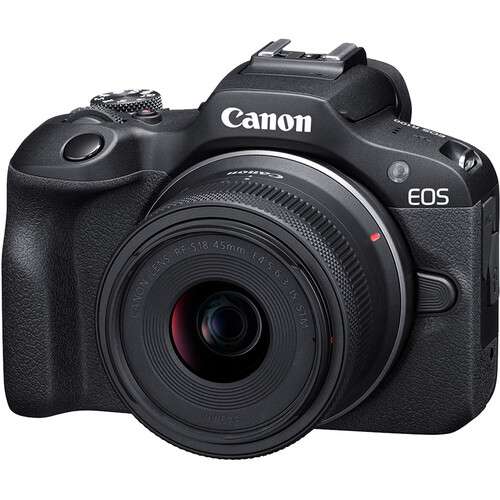
Canon EOS R100 Key Specifications:
- 24.1MP APS-C CMOS Sensor
- DIGIC 8 Image Processor
- 4K 24p Video with Crop, Full HD 60p
- Dual Pixel CMOS AF with 143 AF Zones
- 6.5 fps Electronic Shutter
- 2.36m-Dot OLED EVF
- 3″ 1.04m-Dot LCD Screen
- Creative Assist Mode
- Silent Mode for Quiet Operation
- Wi-Fi and Bluetooth with SD Card Slot
- Weight: 309g (Body Only), 356g (With Battery, Recording Media)
Pros:
- Affordable yet capable
- Great image quality
- Easy to learn and use
- Compact and lightweight
Cons:
- No touchscreen
- 4K video is cropped
- Limited ISO sensitivity
When discussing cameras, the term “cheap” typically doesn’t spring to mind, but there are indeed affordable options available that won’t break the bank. For those wary of purchasing a camera from the secondary market, the Canon EOS R100 emerges as a sensible choice, particularly catering to beginners aiming to minimize costs.
While the EOS R100 may lack the bells and whistles found in more advanced models, it stands out for its simplicity, featuring a fixed screen, streamlined controls, and limited video capabilities. However, it compensates with a high-resolution APS-C sensor, ensuring the capture of impressive images. Furthermore, it boasts an array of helpful auto modes tailored to assist novices in their photographic journey.
Perhaps its most significant attribute lies in its accessibility. For individuals venturing into photography for the first time, the EOS R100 serves as a gateway, offering an entry point that transcends the allure of cutting-edge camera technology. Despite its basic features, if this camera fits within your budget and motivates you to venture out and start shooting, it provides something invaluable – an initiation into the captivating realm of photography.
Canon EOS R100 body at B&H, Adorama.
Canon EOS R100 with 18-45mm Lens at B&H, Adorama.
See also:
Best Beginner Mirrorless Camera for Travel
Fujifilm X-T30 II
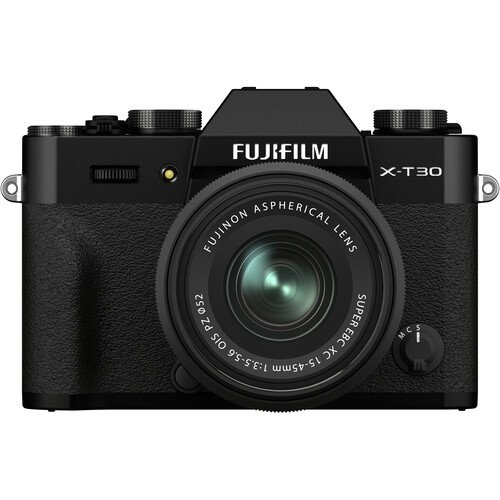
Fujifilm X-T30 II Key Specs:
- 26.1MP APS-C X-Trans BSI CMOS 4 Sensor
- X-Processor 4 with Quad CPU
- Video: Cine DCI 4K/30p and Full HD 120fps
- Max burst: 8fps mechanical shutter, 20fps electronic shutter, 30fps with crop
- 2.36m-Dot OLED Electronic Viewfinder
- 3.0″ 1.62m-Dot Tilting LCD Touchscreen
- 425-Point Phase-Detection Autofocus
- Mechanical and Electronic Shutter
- Extended ISO 80-51200
- Bluetooth and Wi-Fi; Sports Finder Mode
- Ultra-Sonic Vibration Sensor Cleaning
- Weight: 329 g (Body Only), 378 g (With Battery, Recording Media)
- Store links at B&H, Adorama.
Pros:
- Beautiful image quality
- Sleek, retro styling
- Compact, Lightweight but premium build
- Creative film simulation modes
- Uncropped 4K
- Good AF detection
Cons:
- No in-body image stabilization
- No weather sealing
- The screen is tilt-only (not articulated)
The Fujifilm X-T30 II is a fantastic camera for travel enthusiasts and beginner photographers. Its retro design and compact size make it a stylish and lightweight companion on your journeys. Despite its small form factor, it packs a punch with its advanced 26.1-megapixel X-Trans back-side illuminated CMOS sensor, delivering high-quality photos and videos.
One standout feature of the X-T30 II is its built-in film simulation presets. These presets allow you to achieve polished-looking images straight out of the camera, making it ideal for beginners who want stunning results without extensive editing. This feature is especially useful when traveling, as it saves you time that would otherwise be spent on post-processing.
While the X-T30 II is a minor update over its predecessor, it remains an excellent mid-range camera with impressive capabilities. Its sensor and autofocus system perform exceptionally well, ensuring sharp and accurate focus for both stills and videos. Speaking of videos, the X-T30 II offers decent video specs, including 4K recording, making it suitable for capturing memorable travel moments in high resolution.
The camera’s design is reminiscent of Fujifilm’s higher-end models, featuring traditional exposure controls and a sleek black finish. It also boasts a high-resolution OLED electronic viewfinder and a tilting touchscreen LCD for versatile shooting angles and easy image playback. Built-in Bluetooth allows for convenient wireless sharing and remote control.
While the X-T30 II excels in travel and everyday photography, it may not be the best choice for action or sports photography in challenging lighting conditions. Nevertheless, its affordability, compact size, and powerful features make it an attractive option for those seeking a capable and stylish mirrorless camera for travel and everyday use.
Fujifilm X-T30 II body at B&H, Adorama.
Fujifilm X-T30 II with 15-45mm Lens at B&H, Adorama.
Fujifilm X-T30 II with 18-55mm Lens at B&H, Adorama.
See also:
- Best Lenses for Fujifilm X-T30 II
- Best Memory Cards for Fujifilm X-T30 II
- Best Gimbals for Fujifilm X-T30 II
With the abundance of cameras available on the market, spanning a wide range of price points, it’s understandable to feel overwhelmed. However, for beginners venturing into the realm of photography, selecting the appropriate camera is crucial for honing skills and mastering the art in a straightforward manner. Thankfully, the curated list above showcases the best mirrorless cameras tailored specifically for beginners, offering intuitive features and user-friendly interfaces to facilitate the learning process effectively. By choosing one of these recommended options, you can embark on your photographic journey with confidence and simplicity.
Read more:
- Best Cameras Under $400
- Best Cameras for Beginners
- Best Full-Frame Cameras for Beginners
- Best Cameras for Wedding Photography
- Best Compact Cameras for Travel
- Best Sony Cameras for Video
- Best GoPro Cameras